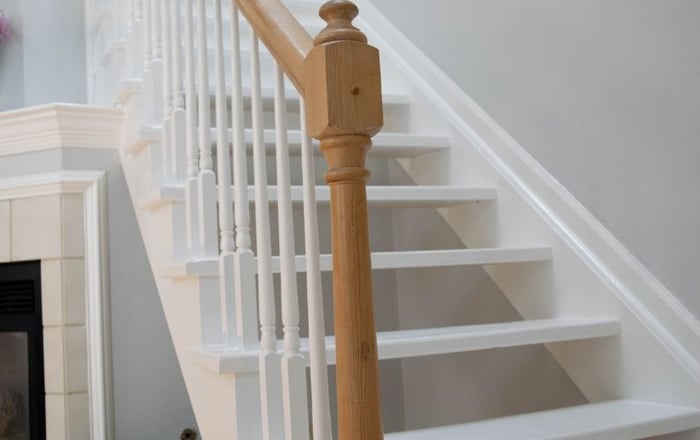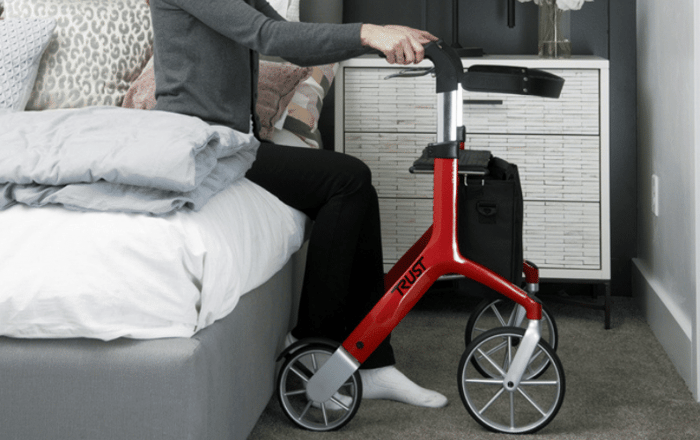Walkers do wonders for mobility, but stairs can still present challenges to people using walkers. Here is how to use a walker when climbing stairs.
By 2031, seniors will make up over 23% of the Canadian population. Many of those seniors will need some type of walking aid, such as a walker. While this helps seniors stay mobile, it makes going up and down stairs more of a challenge. If you'd like other tips on proper walker use, read:
- Your Guide to Using a Walker the Right Way, and
- How to Use a Walker: A Guide for Beginners.
We've put together this guide to show you how to use a walker when climbing stairs. Keep reading to learn more!
How to Use a Walker When Climbing Stairs
Important Note: Please note that certain mobility aids may not be right for you. Always read and follow manufacturer instructions and consult a healthcare professional for more information.
Maintaining body strength can assist with mounting stairs with your walker. Exercising is still possible when using a walker, we recommend Great Tips for Safely Exercising with a Walker.
Keep Potential Hazards off the Stairs
Before you start using the stairway, make sure it is clean of any potential hazards that could cause you to trip and fall.
A few of the things you should remove right away include the following:
- Rugs
- Electric cords
- Boxes
- Other items
If you can't make your stairway walker-safe on your own, ask someone you know to help you. Having tidy stairs will make going up and down with a walker easier and less dangerous.
Don't Try to Carry Anything With You
You'll need to keep one hand on your walker and one hand on the stair rail as you walk up or down the stairs (we'll touch on this again below). Because of this, you should never try to carry anything up the stairs with you when using a walker.
Trying to carry even small items can make you lose your grip on your walker and fall. If you need to take something up or downstairs with you, put them in your pockets or wear a fanny pack or backpack instead. You can also attach a small bag or pouch to your walker for easy, hands-free carrying.
It's a good idea to keep items you often use, such as pens and paper, cups of water, chapstick, etc., both upstairs and downstairs. This way, you won't have to worry about carrying certain items with you every time you go up or down the stairs.
How to Walk Up Stairs With a Walker
Going up a flight of stairs with a walker should be a slow and careful process. Take your time, and if you think you might need help, it's always better to ask someone than risk falling and hurting yourself.
Here's what you need to do when you go upstairs with a walker.
- Turn your walker sideways (with the crossbar facing you)
- Place the front two legs of your walker on the step right in front of you
- Keep one hand on the walker and one hand on the stair rail
- Use the walker and the stair rail to support your weight evenly
- Step up next to the front two legs of your walker with one foot
- Step up with your second foot
- Repeat the process for the next step
If one of your legs is injured or weaker than the other, always step up with your good leg first. Otherwise, you'll put more weight on your injured leg, making the injury worse or causing you to lose balance and fall.
How to Walk Down Stairs With a Walker
Going back downstairs with your walker is a very similar process. However, there are a few important differences you need to be aware of.
Here's a quick walkthrough of the process.
- Turn your walker sideways (again, so the crossbar is facing you)
- Place the back two legs of your walker on the step next to you
- Keep one hand on the walker and one hand on the stair rail
- Use the walker and the stair rail to support your weight evenly
- Step down onto the step in front of you with one foot
- Step down with your second foot
- Continue the process for the next step
Do not put the front legs of the walker down onto the first step. This will shift your weight forward, meaning your risk of falling is a lot higher. It will also make the process much more difficult and awkward. And again, always step with your stronger, uninjured leg first.
How to Go Up a Curb With a Walker
A curb is just one step, but since it doesn't have a handrail like a stairway, it can be somewhat tricky to take that step.
There are two different ways to handle a curb: forward and backward.
Here's how to walk up a curb forward.
- Stand directly in front of the curb
- Lift your walker so all four legs are on the curb in front of you
- Use the walker to support all of your weight
- Push down on the walker as you step up with your first foot
- Then step up with your second foot
- Here's how to walk up a curb backward.
- Turn around so your back is facing the curb
- Use the walker to support all of your weight
- Step up the curb backward with one foot
- Step up with your second foot
- Lift your walker and set all four legs on the curb in front of you
- Turn around and keep walking
If you are nervous about going up a curb by yourself, you should always ask someone to give you a hand.

How to Go Down a Curb With a Walker
You should not use the same method to step down a curb as you do to walk down a flight of stairs.
Here's what you need to do instead.
- Stand in front of the curb
- Lift your walker and set all four legs on the ground below the curb
- Use the walker to support all of your weight
- Step down with your first foot
- Then step down with your next foot
You should never walk down a curb backward. You won't be able to see what you're doing, which could lead to a dangerous fall.
How to Use a Walker When Climbing Stairs
Learning how to use a walker when climbing stairs can take some practice.
If you're having trouble walking up and down the stairs, it might be time to move to a single-story home. This is especially true if you need to use a walker long-term.
Not sure if you should be using a walker?
Learn more about the signs that you may need one here.










